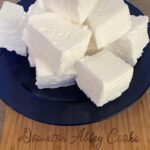Jump to Recipe

Their pillowy texture and subtly sweet flavor are perfect for the long, dark nights of the season. Roasting them over an open fire or hot chocolate transforms marshmallows into melt-in-your-mouth bursts of warmth and nostalgia. They become an integral part of winter traditions, whether you are cozying up with a mug of hot cocoa or assembling s’mores at a bonfire with friends. Even just eating marshmallows straight from the bag reminds you of the simple pleasures of the season. As the temperatures drop and daylight fades early, marshmallows are a wonderful way to create moments of sweetness and joy during the cold months. Their warming qualities and associations with beloved wintertime activities make marshmallows a shining beacon of the joys this season has to offer.
History
Marshmallows have a long and sweet history dating back thousands of years. The earliest marshmallows were made from the extracted sap of the marsh mallow plant, a medicinal herb native to parts of Europe, North Africa, and Asia. The ancient Egyptians were among the first to enjoy marshmallows, using the sticky sap as a honey-like sweetener and for its supposed healing properties. Theophrastus, a Greek botanist in the 4th century BC, also described the marsh mallow plant and how the sap could be boiled with honey to make a sweet treat.
It wasn’t until the 19th century that marshmallows began to resemble the light, puffy confections we know and love today. Candy makers in France pioneered a whipping process that incorporated air into the sugary syrup, creating a pillowy texture. Gelatin replaced marsh mallow sap, allowing for mass production and longer shelf life. The origins of today’s familiar cylindrical shape can be traced to candy street vendors in the late 1800s who passed boiled sugar syrup through tin funnels into cornstarch trays.
Marshmallows rose to even greater popularity in the 20th century, becoming an essential ingredient in desserts like banana splits, s’mores, and rice crispy treats. Major American companies like Doumak and Son of Boston ramped up commercial production using starch molds and mechanized processes. Marshmallow fluff, a sweet spread made from marshmallow creme, also emerged as a favorite sandwich topping and baking ingredient after World War II.
Today, marshmallows are a beloved part of American food culture, eaten by kids and adults alike. Beyond sweetening hot cocoa and crowning sweet potato casseroles, they can be used in many creative ways. Marshmallows add fluffiness to baked goods like cakes, cookies, and brownies. Their mild sweetness pairs well with fruits, nuts, and spices in desserts like ambrosia salad, rocky road, and pumpkin fluff. Marshmallows are even incorporated into some sushi rolls for a unique fusion of flavors and textures.
It is So Easy to Make Your Own
The best part about marshmallows is how easy they are to whip up at home. With just a few simple ingredients like sugar, corn syrup, gelatin, and vanilla extract, you can make your own pillowy homemade marshmallows. The process does require precise timing and temperatures, but is overall quite straightforward. After boiling and whisking the syrup mixture to the right consistency, it gets poured into a pan coated in cornstarch or confectioners’ sugar to set before cutting into squares. The effort pays off in fresh, melt-in-your-mouth marshmallows flavored any way you like.
Whether enjoyed by ancient Egyptians, around a campfire, or in your next batch of homemade rocky road fudge, marshmallows hold a special place in the hearts and histories of candy lovers everywhere. Their sweet appeal continues today, with these light and puffy treats adding flavor and whimsy to all kinds of desserts. So next time you bite into the perfect roasted marshmallow or spread some fluff on your PB&J, appreciate the fascinating origins of this iconic candy.
The Easiest Marshmallows
Equipment
- silicon 9 x 9 pan
- stand mixer
Ingredients
- 1/2 cup cold water
- 3 tbsp. gelatin powder
- 2/3 cup water
- 1 cup Sugar (or sugar substitute)
- 1/4 tsp. kosher salt
- 2 tsp. vanilla extract
Instructions
- If you have a silicone square pan, you will get the best results. Otherwise, line a metal pan with tin foil, then set aside.
- Pour the 1/2 cup of cold water into your stand mixer bowl, or a large glass bowl. The mashmellow mixture will be at least 8 cups at the end. Sprinkle the gelatin in, mix thoroughly with a fork, and allow to bloom for 10 minutes.
- In a small saucepan, add 2/3 cups of water, then pour in the sugar (or substitute) but don't mix. Bring to a boil over medium heat, boiling for 2 minutes. You should not see any sugar crystals at this point.
- Working quickly, turn on your mixer on low (using the whisk attachment) to break up the gelatin, then quickly pour in the hot syrup. Increase your speed to high, and whisk non-stop for about 15 minutes.
- Sprinkle in the salt and vanilla towards the end of your 15 minutes. The mixture will look like stiff egg whites, totally filling your bowl.
- The mixture will set quickly so you will need to pour the marshmallow batter immediately onto your prepared dish.
- The hard part now is to let the marshmallows to completely dry at room temperature. Ideally, but for at least 6 or 7 hours.
- When completely dry, you should be able to easily, yet gently, remove the pan. Cut into squares with a greased knife. You shouldn't have a problem with sticking, but if you do, dust lightly with powdered sugar substitute.
- You can store in an airtight container for a few weeks or pop into your freezer.
